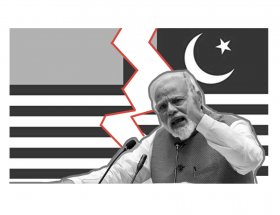On whether immigrants cause intolerance or protect us from it.
Le Pen. Farage. Salvini. Orbán. Kurz. Trump. Far right xenophobia is in vogue across the West. The fear, or rather hatred, of immigrants and foreigners, is arguably shaping our political landscape more than any other ideology. Nations that were considered bastions of liberal democracy are crumbling under its weight. The European Union, arguably the most ambitious attempt at increasing international freedom of movement, is growing smaller and weaker, authoritarianism clawing its way to power in the east. In the US, the land of the tired, the poor, the huddled masses, calling immigrants rapists has been validated as a path to the presidency.
Amidst the political revolution against internationalist tendencies, one can’t help but wonder what is responsible for their rise. Not responsible in a philosophical way, meaning ethically accountable, but rather in a practical one, as in what variable caused this chain of events. For many on both sides of the political spectrum the answer is indisputable: large-scale migration.
The idea that a large influx of foreigners triggers xenophobic hatred appears logical at first. It suggests that as immigrants move to a nation, they compete for employment with locals, depressing their wages. Similarly, partly thanks to sensationalist media coverage of terrorism, many associate migration with higher crime rates. The above could, in the eyes of some, trigger populistic backlash. Immigration would be, in short, reducing tolerance and threatening our liberal democracies.
This explanation can be tempting. If destructive and unorthodox political outcomes were fuelled by excess migrants, the solution ought to be as simple as reducing their number. Such a viewpoint implies that, but for the increase in the immigrant population, our societies would have remained safely anchored to conventional parties and political moderation. Essentially, it shifts the responsibility for the current upheaval from the policies of the political establishment to the migrants themselves. This approach has proved appealing to some high-ranking politicians, such as German Chancellor Angela Merkel. Mrs. Merkel, who once welcomed a million refugees into her country, recently agreed to “border camps” for migrants, hoping to salvage her Bavarian coalition partner from the rise of the far right AFD.
There is just one caveat: socio-economic analysis discredits such an interpretation. Even as immigration rose, crime fell across the West- not least in Mrs. Merkel’s own nation, where it plummeted to its lowest level since 1992. Even if migrants can slightly depress the wages of lower-income workers, the academic consensus is that their overall economic impact is positive, increasing aggregate demand and slowing the demographic ageing of recipient countries. Even concerns over their fiscal impact are overstated, as they are usually unable to claim welfare benefits. The purported damaging side effects of immigration are minimal or non-existent.
So, given that its societal impact is relatively minimal, how has immigration managed to remain in the public spotlight, let alone to command such influence on our democracies? The explanation could be that the current political discourse is, to some extent divorced from reality; policy is increasingly derived from ideology rather than from empirical evidence, frequently becoming contradictory. The same polity that defends reducing migration for fiscal reasons supports doing so by building a border wall costing upwards of 20 billion USD. Still, this doesn’t tackle the key issue at hand: if immigration isn’t responsible for xenophobia and the reduction of tolerance, what is?
To understand what lies behind the current surge in xenophobia it is vital to analyse its precedents. The United States provides perhaps the best historical examples, given its tumultuous and well-recorded interactions with foreigners. In the 1870’s, as the economy slowed down in what is known as “the long depression”, animosity towards Asian immigrants skyrocketed, culminating in the passage of the Chinese Exclusion Act of 1882. The legislation, which was in place for over six decades, barred any Chinese citizens from immigrating to the United States, and was accompanied by riots against existing communities. Barely fifty years later, the great depression triggered the Mexican repatriation, with Mexicans and Mexican-Americans who were blamed for the economic downturn being deported by the hundreds of thousands.
In both of these examples, the fall in living standards and average incomes closely correlated with the rise of xenophobia. This is hardly coincidental; several sociological studies, such a 2004 report by the international labour organization, have established a link between economic security and tolerance. Essentially, civil society is more open to pluralism when its wellbeing is assured, but less so when the state of affairs- defined, for instance, by unemployment or wage growth- worsens. Under these circumstances migrants can often become scapegoats for an underlying societal decay that is largely unconnected to them. Society falls into nativist tendencies, and diverts its attention from the complex problems that increase its socio-economic insecurity to the easily identifiable “other”, the archetype of the job-stealing immigrant who can bear the onus of their troubles. From an anthropological perspective, we are predisposed to blame an outsider for the ills of our group, even when they are internal in nature.
This isn’t meant to downplay the relevance of ethnocentrism and racial prejudice on recent political decisions; rather it explains how the economy and cultural bias are interrelated, how existing preconceptions of other social groups can remain somewhat dormant under prosperity and galvanise under hardship. Our current wave of intolerance is hence rooted in economic anxiety and anger against the failures of the economic system. Perhaps the most likely culprits are the stagnation of middle-class wages, with partial erosion of purchasing power in some communities, and the intertwined rise in inequality. This could also explain why other nations with proportionately large migrant populations have managed to retain or increase their societal tolerance for newcomers. In the case of Canada, for instance, no far-right political party has risen against its 21.9% foreign-born population, even as it increased its intake in 2016 to the highest level in six years. The cause for this tolerance might be partially cultural, but it’s also undoubtedly linked to its continuously high wage growth. Should the US economy be reminiscent to that of Canada, it seems unlikely that populism would have flourished.
Once we accept that xenophobia is separate from the immigrants themselves, the arguments in favour of drastically reducing immigration falter. If migrants reflect, rather than provoke, a decrease in social tolerance, cutting their number would not reduce the populist backlash. Indeed, implementing such a policy could have, two different outcomes.
The cuts to immigration could, hypothetically, coincide with an increase in socio-economic security. In this scenario, the polity which implemented them would only be emboldened, strengthening nationalistic tendencies. Such is the case of soft-Eurosceptic Viktor Orbán in Hungary, who prompted a moderate economic improvement as he implemented anti-migrant policies, leading to his re-election by a significant margin in 2014 and 2018. His bigotry has been reaffirmed and strengthened but remains largely focused on immigrants.
Such a course of events is by far the better alternative. When the migrant population is low or a receding problem during a crisis, the outcome can be far more dangerous. As asserted before, society looks for demographics to blame for the broader struggle of the group. Should it fail to find an external “other” to stigmatise, the underlying anger and unease would be diverted to national subsectors of society, such as political factions, members of the LGBT community or ethnic minorities. Precedents for such a conduct are easily identifiable in recent politics. Prior to the rise in migration in 2015, Orban’s party ostracised other groups, with an MP claiming that homosexuality was a mental illness and aiming to ban pride, whilst another alleged that Roma women purposefully “hit their bellies with a rubber hammer” to birth handicapped kids entitled to welfare.
Thus, migrants serve as a “buffer group”, fulfilling the role of societal enemy effectively and preventing other groups from doing so. It is especially noteworthy that the struggles they endure, even deportation, whilst traumatic, undesirable and frequently inhumane, are relatively less damaging than those suffered by a native born- they can return to their home country (in the case of economic migrants) or attempt to migrate elsewhere, and usually value their improved living standards relatively more than the bigotry they endure. Native to-be-scapegoats face harsh legal discrimination and, lacking an “origin country” to return to, are potentially more exposed to long-lasting suffering. Preserving migrants, and working to ensure they are accepted, could be one of the most effective mechanisms to prevent a further fragmentation of civil society.
From a purely selfish national perspective, reducing immigration would be detrimental to the interest of native citizens. If the West truly desires to increase tolerance, it must focus on the roots of its social insecurity, tackling falling incomes and rising inequality, whilst allowing migrants to keep enriching our society and protecting our most vulnerable from their fellow countrymen.





An extremely well written piece!!